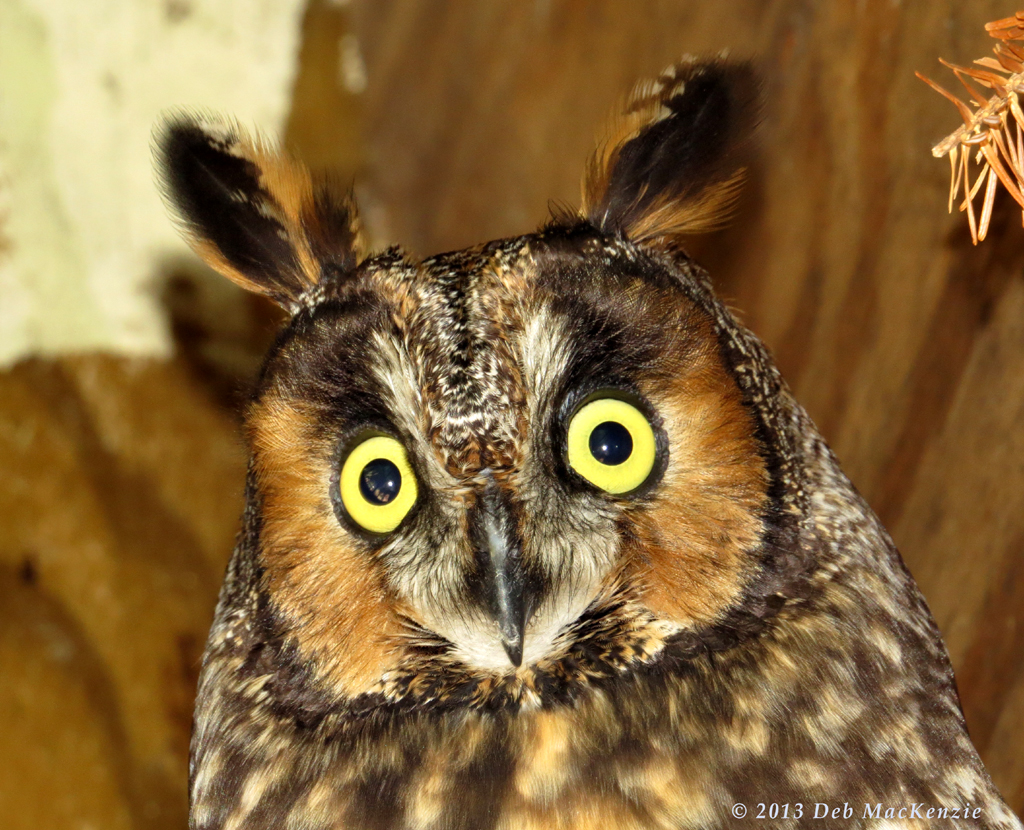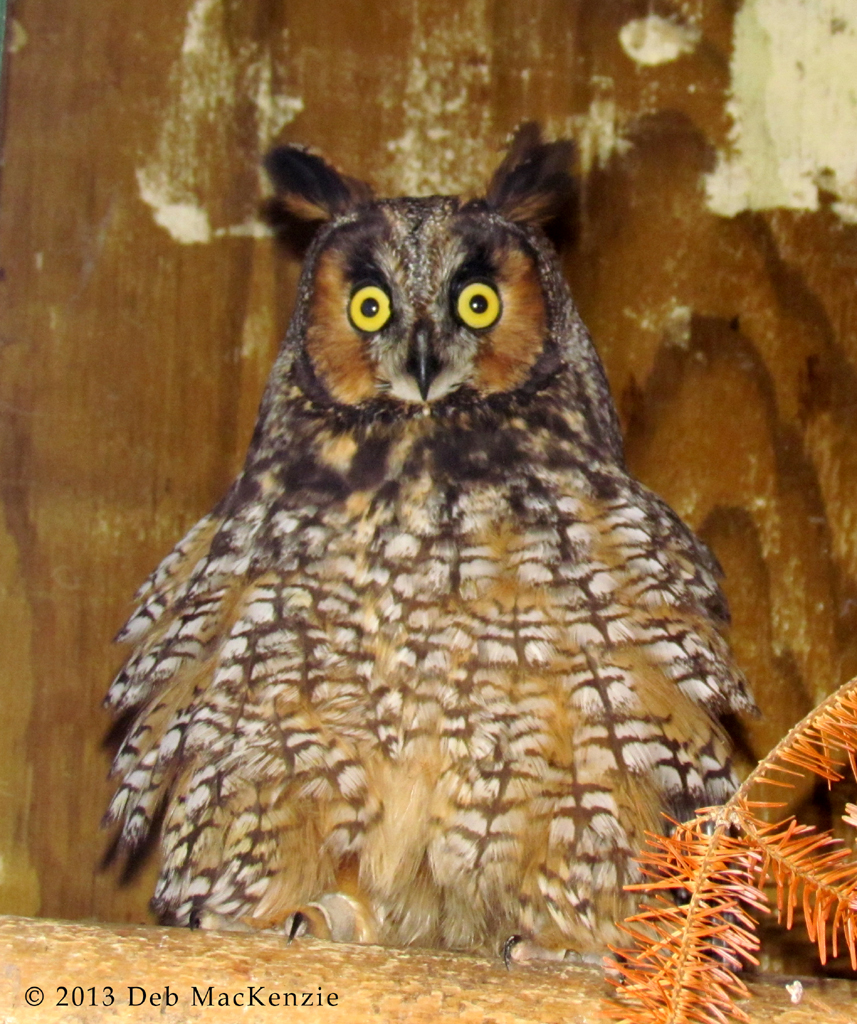ns
"It is the owl that shrieked, the fatal bellman Which gives the stern'st good-night."
Shakespeare, Lady Macbeth in Macbeth








Long eared owl by Deb MacKenzie, left portrait, right defensive posture
|
Long
eared Owl Genus: Asio Owls are birds of prey of the order
Strigiformes, which are
divided into two main families. Strigidae has 220 wide ranging species,
for
example round faced owls filling all possible sizes between the great
horned
owl and the elf owl. Tytonidae has 20 species, distributed worldwide
everywhere
but the polar regions and northern regions from Canada through eastern
Russia, for
example, heart faced owls like the barn owl. Eight owls are found in
the
Adirondacks: Snowy
owl seasonally, Great Horned owl, Barred
owl,
Long eared owl, Short eared owl, Barn owl, Eastern
screech owl and Northern
saw whet owl, all year-round residents. Ancestors of Strigiformes,
or true
owls, show up in the fossil record up to 68 million years ago, three
million
years before the crashing of a comet into the Yucatan Peninsula,
resulted in
the extinction of all large dinosaurs and mammals over 50 pounds.
Tytonidae go
back about 58 million years. Birds are the direct descendants of
dinosaurs,
essentially what is left of theropod
dinosaurs. Long eared owls look like a smaller version
of the Great
Horned Owl, which decided to go on a crash diet, and appears
perpetually
startled at the result, but they differ from their Strigidae relatives
in
several important ways. Medium sized owls between 14 and 16 inches
long,
weighing half a pound to a pound, and with a wingspan of about three to
three
and a half feet, long eared owls are more communal and less strictly
territorial than other Strigidae, seeming to move around based on the
availability of their most common prey, voles and other small rodents. The most striking feature of long eared owls
are their plumicorns
or ear tufts, which are longer than those found on great horned owls,
and
closer together on top of the head. We really do not know the
evolutionary
purpose of ear tufts, even though there are 55 species of Strigidae
which
feature them. The most supported explanation is that ear tufts break up
the
outline of nocturnal owls, which roost by day, aiding in camouflage,
allowing
the motionless owl to blend in against its background, which is mainly
bark,
branches and thickets. Some experts posit that the ear tufts, which
have nothing to
do with hearing, and are so called because of their position on the
owl’s
heads, make the head appear larger and more forbidding, resembling a
mammalian
predator’s head, but it seems to me that the most intimidating feature
of owls
are their disproportionately enormous eyes, a feature mimicked by
certain bugs,
caterpillar and fish, which feature large spots that appear to be eyes
evolved
to impress would be predators. There are suggestions that the position
of ear
tufts indicate mood, but I am not aware of any studies which indicate
that. I
have noticed that whenever I have handled a long-eared owl on a
falconer’s
glove, its ears are stiffer and more erect than when they are roosting.
Perhaps
all these observations play a role. Female owls seem to respond to
courtship
displays, while alarmed or aroused owls threaten with loud bill
snapping. Great
gray owls look handsome, great horned owls threatening, but long
eared owls
look surprised, their enormous eyes framed in a round face on their
neckless
ovoid frames, the ear tufts straight up and down like exclamation
points. The
facial disk, with its ruff feathers suggest a faded orange, while the
bristle
feathers around the bill and between the yellow to orangish eyes form
an off
white “X”. The feathers of the upper breast resemble a blotchy vest,
while the
lower breast has lighter vertical brownish patches, sometimes in a
feathery scaled
appearance. Female feathers tend to be somewhat darker than the males,
perhaps
making them harder to spot while sitting on a nest. Owl’s legs are
longer than
they appear to be, sometimes as long as their body’s length, with much
of the
leg hidden under the owl’s plumage. Legs are feathered down to the
large
talons. Migratory in their more northern range only,
the breeding
territory of long eared owls in North America stretch from about 100
miles
inside the coast of British Columbia down the west coast of the United
States,
north from a thin southern slice of the Yukon, east touching the
southern tip
of Hudsons Bay, extending all the way to Nova Scotia on the east coast.
south
to New Mexico and Arizona, then swinging north through the Midwest to
the great
lakes. Wintering is done in the rest of the Southeast of the U.S. and
in
Mexico. Europeans and Asian ranges fall within the same general
latitudes. Long
eared owls live about ten years in the wild, much longer in captivity,
where
starvation is removed as a threat. Long eared owls are not territorial the way
most owls are,
moving around to areas where prey is most abundant. During the
non-breeding
season, long eared owls roost by day in thick woodlands at the edge of
hunting
areas, often sharing a tree which provides good cover, all trying to
blend in
with tree trunks, branches, and thickets, sometimes in multiple trees
in groups
of nearly 100 birds. A group of long eared owls is called a parliament.
Like
screech owls, long eared owls will stretch and twist their torsos to
resemble
branches or snags on trees. Long eared owls must be adept at flying
through dense
forest to reach hunting grounds. They hunt by night, perching and diving at
movement or
sound, but they also glide and flap, cruising over clearings, open
fields, and
riparian areas, only about six feet off the ground, sometimes hovering,
before
diving on their prey. In the Adirondacks, prey will usually be small to
medium
sized rodents like voles, white footed mice, squirrels, chipmunks, and
rabbits,
as well as small songbirds, such as juncos, bluebirds, oven birds,
thrashers
and occasionally mourning doves and grouse. They will also take
invertebrates, reptiles,
and amphibians. Prey are killed or immobilized by the sharp talons and
bill.
Smaller prey is swallowed whole or brought back to the nest in the bill
for
sharing. Larger prey is torn apart or carried in the talons back to the
nest. As with other owls, the eyes are not
spherical, but rather
long and tubular, locked into the sclerotic rings of the eye sockets,
such that
an owl cannot move the eyes independently, having to turn its head in a
270
degree sweep on 14 neck vertebrae, twice the number humans have. Both
eyes face
front, giving owls superior binocular vision for greater depth
perception in
determining the location of prey. The eyes are dominated by motion
sensing rods
over color detecting cones, so the emphasis is on detecting movement of
prey
rather than discerning color differences. Hearing is the owls secret weapon, and most
critical in
locating the exact location of prey. The ears are located right behind
the eyes
in the facial disk, and are staggered, with the right ear larger and
higher on
the disk than its counterpart on the left, with the result that sounds
below or
to the left, land on the left ear microseconds before landing on the
right. The
owl turns its head through its medial and radial axis, until the two
sounds
coordinate, and because the eyes cannot be moved independent of the
motion of
the head, the owl must at that point be staring at the prey’s location.
This triangulation
of the prey’s location is dynamic in the sense that as the owl and the
prey
continue to move, the prey’s changing location is constantly updated,
such that
the long-eared owl is even more adept at locating prey in the dark than
barn
owls are. As with other owls, flight feathers of long
eared owls
feature tiny comb like serrations on the lead edge, as well as soft
fringes on
the outer edge, which break up the sounds of flight, enabling silent
flight,
such that prey targets cannot hear the owl approaching, just as the owl
is not
distracted by the sounds of his own flight, while triangulating the
positions
of moving prey. Steve Hall
|
by Brenda Dadds Woodward



Long eared owl by Deb MacKenzie
| Home |
Release of
Rehabbed Animals |
Learn
About Adirondack & Ambassador Wildlife |
Critter
Cams & Favorite Videos |
History
of Cree & the Adirondack Wildlife Refuge |
or a buzzard or even a popinjay, but a solemn writer is always a bloody owl."
Ernest Hemingway
Great site for owl information and resource